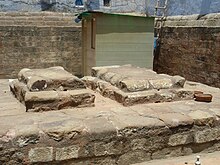Razia Sultana
| Razia Sultan | |
|---|---|

Grave of Razia Sultan in Bulbul-i-Khan near Turkmen Gate, Delhi
|
|
| Sultan of Delhi | |
| Reign | 10 November 1236 – 14 October 1240 |
| Coronation | 10 November 1236 |
| Predecessor | Rukn ud din Firuz |
| Successor | Muiz ud din Bahram |
| Born | 1205 Budaun, India |
| Died | 14 October 1240 (aged 35) Delhi, Delhi Sultanate |
| Burial | Bulbul-i-Khan near Turkmen Gate, Delhi |
| Spouse | Malik Altunia full name Malik Ikhtiaruddin Altunia or known as Mirza Altunia |
| Issue | Zubrudin Mirza Rashil (1237–1238); adopted son |
| Dynasty | Mamluk |
| Father | Iltutmish |
| Mother | Qutub Begum |
| Religion | Islam |
Raziya al-Din (1205 – October 13, 1240), throne name Jalâlat-ud-Dîn Raziyâ, usually referred to in history as Razia Sultana, was the Sultana of Delhi from 10 November 1236 – 14 October 1240. She was famously the only female ever to rule the Delhi Sultanate.
Raziya was the daughter of Shams-ud-din Iltutmish, who had begun life as a Turk slave and ended it as Sultan of Delhi. Iltutmish had been a great favorite of his master, Qutb ud din Aibak, the first Sultan of Delhi, so Aibak had his daughter Qutub Begum married to Iltutmish. Qutub Begum was the mother of Razia, and Razia was thus a maternal granddaughter of Qutb ud din Aibak and Shamshad Begum (Valide Sultan). Razia also had a brother, Nasiruddin Mahmud. Razia, being a member of the ruling family, grew up in privileged circumstances and was close to the levers of power both within the harem (where her mother was dominant) and in the court, where she was a favorite of both her maternal grandfather and her father. This was in contrast with her step-brothers Rukn ud din Firuz and Muiz ud din Bahram, who were the sons of former slave-girls, and thus grew up quite distant from the centers of power.
When Razia was five years old, Qutb ud din Aibak died and was succeeded by Iltutmish. Razia was a favorite of her father, and as a child was allowed to be present around him while he dealt with affairs of state. Later, like some other princesses of the time, she was trained to administer a kingdom if required, in the absence of her father or her husband. Her abilities and diligence, no less than her mother's royal lineage, commended Razia to Iltutmish and made her a confirmed favorite with him. Nevertheless, it was Iltutmish's eldest son Nasiruddin Mahmud (Razia's brother) who was groomed by Iltutmish to succeed him.
However, Nasir ud din Mahmud died suddenly in 1229 CE, and Iltutmish was at a loss as to a successor, because he felt that none of his several surviving sons, born of his other wives, were worthy of the throne. In 1230, he had to leave the capital in order to lead an invasion against Gwalior. During his absence, Razia acted as a competent regent, with the assistance of the Sultan's trusted minister. Iltutmish returned to Delhi in 1231 after having captured Gwalior, and the issue of succession was foremost on his mind. Iltutmish became the first sultan to appoint a woman as his successor when he designated Razia as his heir apparent. Razia was the first and only female ruler of Delhi Sultanate. However, after Iltutmish died on Wednesday 30 April 1236, Razia's step-brother Rukn ud din Firuz was elevated to the throne instead.
...
Wikipedia
